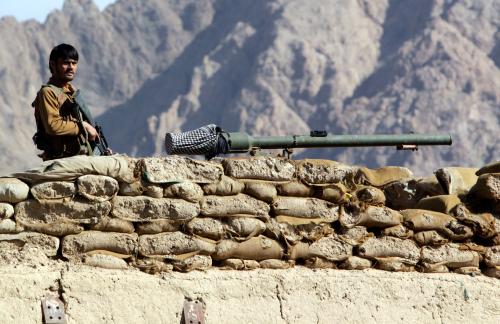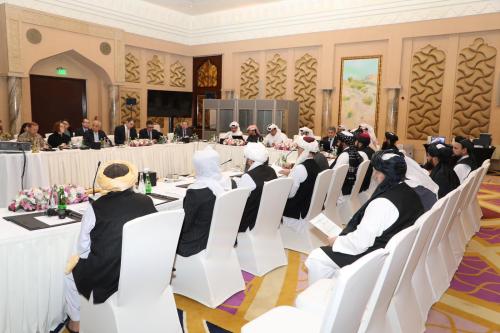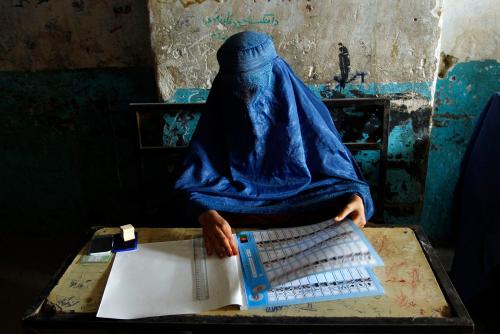Fifteen years have passed since September 11 and the subsequent overthrow of the Taliban in Afghanistan. There have been numerous accomplishments in the allied effort to stamp out terrorist activities during that time, and Afghan security forces are showing significant resolve to continue the fight. But the insurgency remains entrenched, and violence in Afghanistan has been escalating of late.
On September 6, Brookings’s Center for 21st Century Security and Intelligence (21CSI) hosted a discussion on current security and political dynamics in Afghanistan. The conversation also evaluated U.S. interests in the region, including counterterrorism objectives. Brookings Senior Fellows John Allen (also co-director of 21CSI), Vanda Felbab-Brown, and Bruce Riedel offered their thoughts, and 21CSI co-director Michael O’Hanlon moderated the discussion.
Bright spots in the dark
Following acknowledgments from O’Hanlon for the victims of the 9/11 attacks—as well as the armed services, intelligence groups, and others who have participated in actions since that fateful day—Allen began by pointing out that long-term success in Afghanistan will be a function of the security environment and the capacity of the Afghan National Security Forces (ANSF) to provide security. While the ANSF has shown itself to be quite capable, “the situation has become more challenging, perhaps even worrisome over the past several months to a year,” said Allen.
He argued that the ANSF needs to “control population centers and not give up any more districts,” and said he believed that Afghan forces and their partners will be able to take back territory lost in the past year. Key challenges for the United States include strengthening the U.S. relationship with the ANSF, as well as buttressing the Afghan army via air support.
Felbab-Brown argued that this is “probably the most challenging of any time since 2002”—challenging both for the Afghan people and for international civilians assisting in governance and economic growth initiatives. Part of today’s problem, she contended, is that the environment in Afghanistan is un-permissive: Safety outside population centers like Kabul is far from guaranteed, the government is cut off from large portions of the country, and civilian casualties are high.
On the political situation in Afghanistan—namely uncertainty about the future of the National Unity Government (NUG)—Felbab-Brown concluded that there is an opportunity for the country’s government and politicians: politics in Afghanistan cannot be about brinksmanship, and once the government can get itself out of current crisis about the future of the NUG, there will be a chance to “govern in a more robust and less corrupt way.”
Riedel highlighted that there is also good news in Afghanistan. He reminded the audience that back in 2009, the top goals of the Obama administration in Afghanistan and Pakistan were to “disrupt, dismantle, and defeat al-Qaida.” He alluded to many successful and foiled al-Qaida plots in the years prior, with far fewer emanating from there since. “The organization has been substantially degraded,” Riedel said, recognizing that the situation still requires monitoring.
We need to “take the safety out of the safe havens,” Riedel stated.
The Pakistan piece of the puzzle
Pivoting to Pakistan, Riedel pointed to the May killing of Mullah Mansour as a model: Rather than returning to a tempo of drone strikes seen at the height of the U.S. operation, Riedel argued for a focus on disrupting and dismantling sanctuaries. We need to “take the safety out of the safe havens,” Riedel stated.
He later emphasized this point, indicating that the strike against Mansour was deep into Balochistan, and not near the border. Even when insurgent leaders are stationed in cities, they will move around at times, and this movement presents opportunities to strike. Such operations are vital, and will make it difficult for “business as usual” to continue.
Delving further into the Pakistan part of the equation, Riedel gave insight into the patronage of the Afghan Taliban by the Pakistani army. At times, the Pakistani Army has been actively engaged in training, funding, and planning of the Afghan Taliban.
He also explained that Pakistan is a unique country: It has a thriving free press and has seen recent transitions from one democratically-elected government to the next. That’s a milestone, and Riedel argued that going after safe havens will help give the civilian government—which is more or less aligned with U.S. objectives in the region—space to lead.
Allen recalled trilateral commission meetings between himself, the chief of staff of the ANSF, and the chief of staff of the Pakistani army. One day, he hoped aloud, perhaps that meeting could take place without an American participant—after all, he emphasized, a good relationship between Afghan security forces and counterparts in Pakistan is crucial to finding a long-term solution to the Afghanistan conflict. And eventually, the “relationship can be robust enough to sustain security of the frontier,” Allen said.
Felbab-Brown agreed about Pakistan’s importance to Afghanistan’s security and stability, but pointed out that Pakistan is “always used as an excuse not to improve Afghan governance.” This has perpetuated policies that are ill-conceived, she argued. She believes any lasting solution will need to be a political one. As questions about changes, including potential increases, in U.S. military engagement swirl during the U.S. election cycle, Felbab-Brown made it clear that improving governance and political processes in Afghanistan is an indispensable element of U.S. strategy, regardless of the number of U.S. soldiers in the country.
Felbab-Brown made it clear that improving governance and political processes in Afghanistan is an indispensable element of U.S. strategy, regardless of the number of U.S. soldiers in the country.
Glass half full?
Although the overall tenor of the conversation was guarded, the speakers also offered reason for hope. Colonel Joel B. Vowell of the United States Army—and a new Federal Executive Fellow at Brookings—gave brief remarks on what he learned over several tours in the country. Vowell stated that “Afghanistan is hard, and it’s hard all the time,” but also shared his surprise at where the ANSF is today compared to his earlier missions. During his tour in 2015, for instance, Afghans were leading missions and owning the problems of the battlefield, holding terrain, and doing counterinsurgency their own way (which has often worked). To this, O’Hanlon noted: “It is going to take President Ghani and Chief Abdullah to find, if they can, commanders of comparable ability, and put them in positions in the other corps.”
All the speakers therefore agreed that change in Afghanistan can take a long time, and that the future is uncertain. But, in Vowell’s words, there may be reason to feel “rationally optimistic” about how things are going and where they are headed. Afghanistan may yet find itself on a path that eventually leads it out of conflict, if pragmatic and long-lasting solutions to its challenges can be found.






Commentary
Reflecting on 15 years in Afghanistan
September 12, 2016